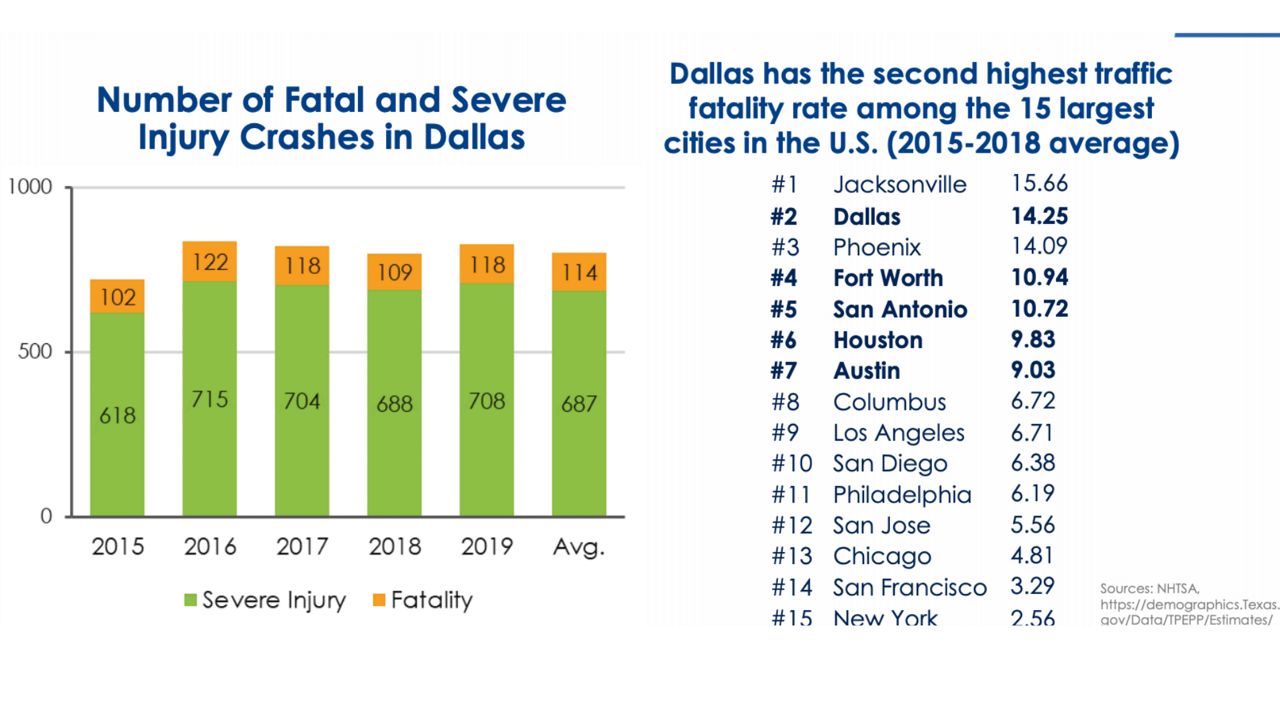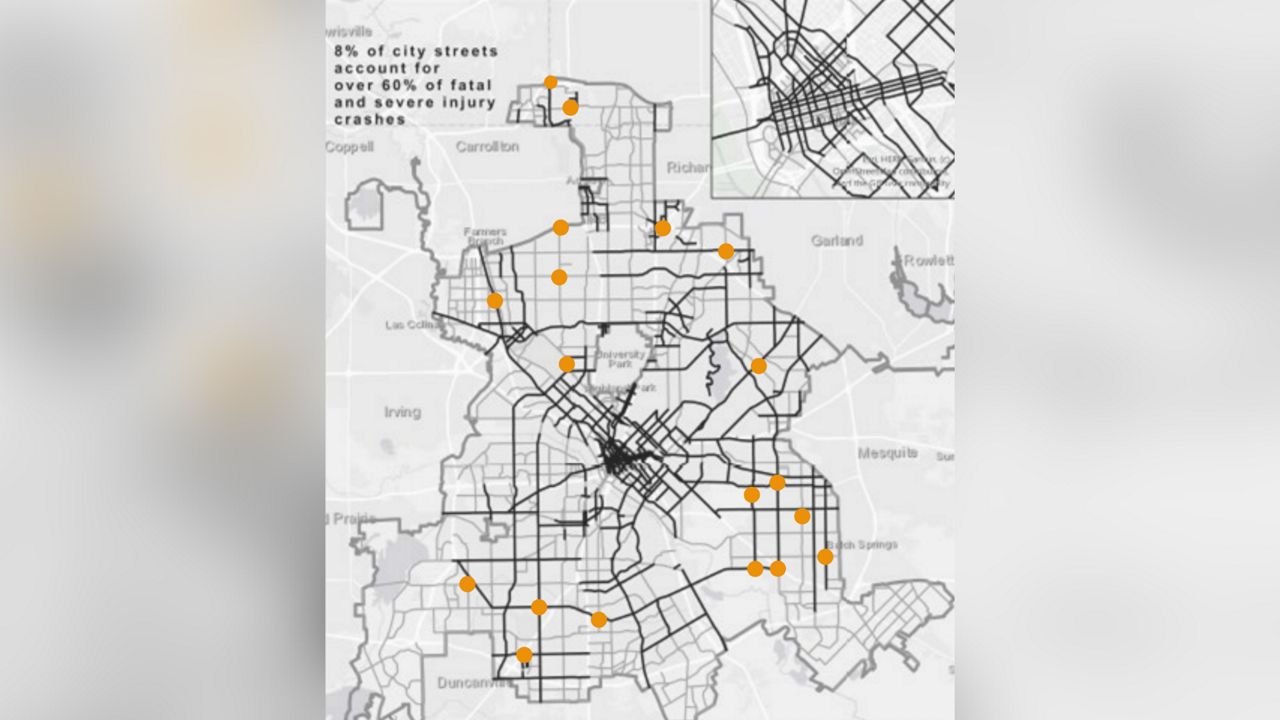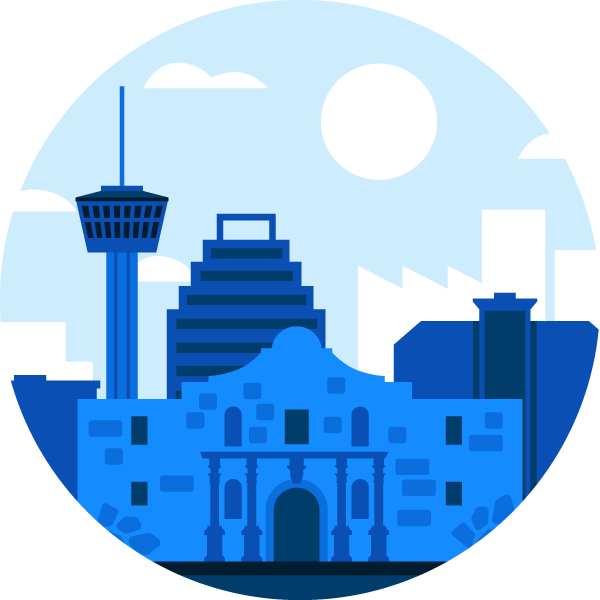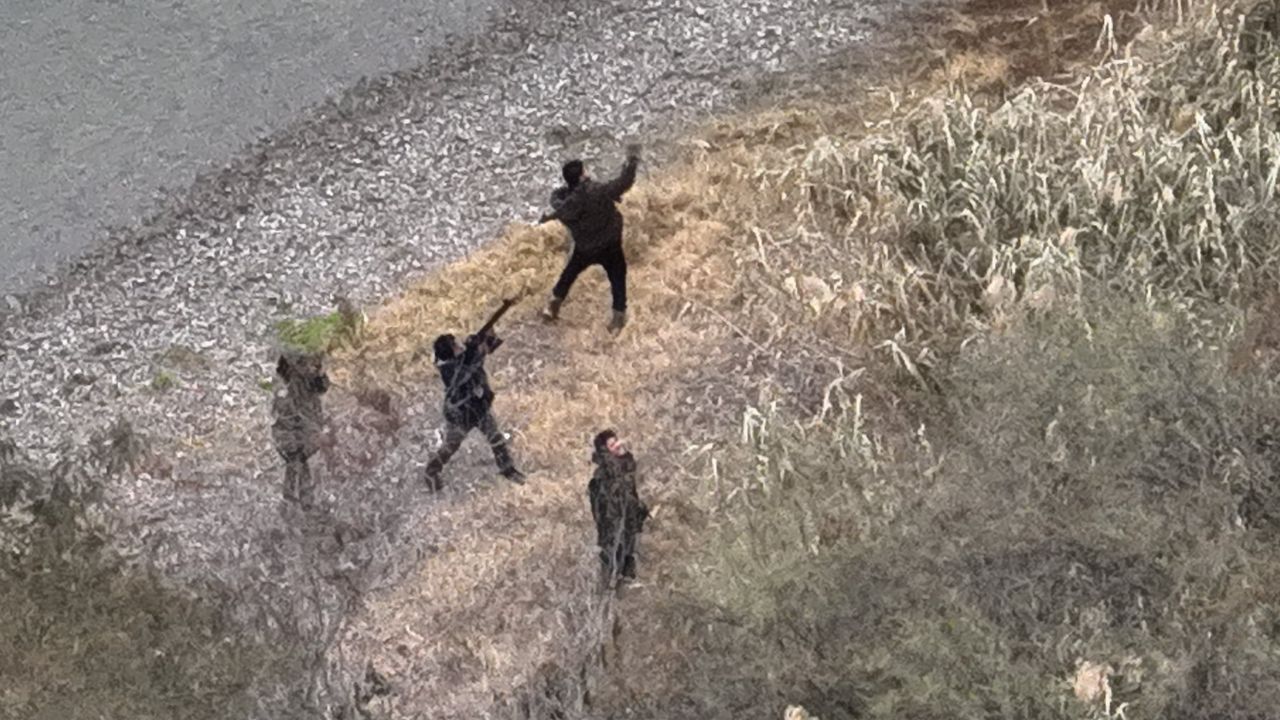DALLAS — Cities in Texas, like Dallas, are embracing the anti-crash strategy called Vision Zero. The city is asking for residents’ help improving safety on the road by giving feedback on the most critical areas where safety should be addressed.
Dallas is committed to becoming a Vision Zero city, one that has a goal of eliminating traffic deaths and cutting severe injury crashes in half by 2030. Other major Texas cities like Austin, San Antonio, Houston and Laredo have all committed to Vision Zero. The strategy is recognized nationwide to eliminate traffic fatalities, and it’s based on the belief that no loss of life is acceptable. Vision Zero cannot be achieved without a focus on the 5 E’s: Engineering, Enforcement, Education, Evaluation and Equity.
The city has established a Vision Zero Task Force consisting of representatives of multiple city departments and external agencies who all have a stake or role in improving how everyone travels around Dallas. The external agencies taking part in this task force are TxDOT, Baylor University Medical Center, Parkland Injury Prevention Center, Mothers Against Drunk Driving, AARP, BikeDFW, Dallas County Health Dept., Dallas ISD and NCTCOG.
"In 2019 Dallas City Council set a goal of eliminating traffic fatalities and cutting severe injuries in half by 2030,” a city statement reads. "Vision Zero is an internationally recognized strategy used by cities all over the world that helps work towards this goal. The City of Dallas has committed to creating a Vision Zero Action Plan that will be data driven based on community input.”
That community input is being collected through a Vision Zero survey, available until mid-August. This public feedback will help guide the development of the Vision Zero Action Plan, which is being worked on with only internal staff resources. However, residents can also identify locations and upload pictures of a particular safety concern using this form. The plan’s scope of work is as follows — using public and stakeholder engagement, crash data analysis and identification of focus areas, a review of best practices (the 5 E’s), assessment of existing practices and policies. This work will ultimately be used to formulate new strategies, policies and an implementation plan to finalize the Vision Zero Action Plan by December 2021.
A presentation from the Dallas Department of Transportation from early June briefed city council on the progress in developing the Vision Zero Action Plan. Since Vision Zero is a data-driven approach, the first step was crash data analysis intended to answer questions about what locations, times of day and factors lead to severe crashes, and if they are more likely to occur based on the characteristics of the built environments.

The presentation showed that between 2015 and 2019, on average, Dallas had 114 fatality crashes and 687 severe injury crashes each year. Dallas is listed as having the second highest traffic fatality rate looking at NHTSA’s data from 2015 to 2018. The list also included four other major Texas cities. Fort Worth was number 4, San Antonio was listed as number 5, Houston was number 6 and Austin was number 7.
Also of note, the city identified the streets and intersections where high numbers of people have been killed or severely injured. The High Injury Network showed that 51% of fatal and severe injury crashes occurred on Principal Arterial streets. Crashes also occur more frequently during the sunset hours, and looking at data from TxDOT between 2013 and 2017, 86% of fatal and severe crashes occurred at or around intersections. Of the top 20 intersections with the most fatal and severe injury crashes, all but one have received funding for signal improvements. For 16 of them, the Department of Transportation applied and was awarded funding through the state Highway Safety Improvement Program (HSIP).

The analysis also showed 8% of streets in Dallas account for more than 60% of fatal and severe injury crashes and 5% of streets in Dallas account for more than 53% of fatal and severe injury pedestrian crashes. The top factors that contribute to crashes are speed related, under the influence, failure to drive in a single lane, pedestrian failure to yield to vehicles and failure to yield when turning left. According to the Connect Dallas Strategic Mobility Plan released in January 2021, “although walking trips account for less than 2 percent of work trips in Dallas, pedestrian fatalities represented 27% of all traffic fatalities in 2017."

When it comes to getting around Dallas, it’s not always the easiest whether you’re driving, using micromobility, or walking. In spring 2021, an RV rental company called Outdoorsy wrote on its blog that Dallas had the most dangerous drivers, listing the city as the “most dangerous city for driving.” The company used data from NHTSA to identify the city’s collision likelihood relative to the U.S. average, the total vehicle fatalities per 100,000 people, and the percentage of fatal collisions involving a drunk driver. The blog listed Dallas as having a composite index score of 88.48. For comparison, Fort Worth was listed at number 6 with a score of 77.84, Houston was number 8 with a score of 76.20.
No Texas city made the company’s “safest cities for driving” list.
After living in the Dallas area more than four decades, cyclist Emily Goode has her fair share of experiences getting around the metroplex. She’s seen where Dallas has improved its roads, but knows there’s still a ways to go, not only for drivers but for bicyclists like herself, and pedestrians.
“[Roads in Dallas] have definitely come a long way. I'm really impressed with the changes that I have seen the last decade or so as a cyclist. I really do see where Dallas is trying where they didn't before. So, I appreciate it,” Goode said. "One thing I really see a lot of is, for one, distracted drivers. It's amazing how many people are just on their phone. I am amazed.”
Goode is excited Dallas is taking on the goal of committing to becoming a Vision Zero city.
“We already have cars that are aware of what's near them and if we have drivers that are also aware of what's near them, maybe we wouldn't kill each other out on the roads,” Goode said. "I really do intend to be more part of the conversation as decisions are made. Because we've got really great people making decisions, and the more we are having open ongoing conversation of what infrastructure works and we get feedback quickly of like, ‘Oh, that sounded good in theory, but it actually created a problem.’ So, the sooner we can have a feedback loop on that, the better."
Goode said she has to always keep her head on a swivel when she’s biking and over-communicate with the vehicular traffic around her. She said she wants drivers to change their thinking when it comes to bicyclists and create more awareness.
“We act like it's driver versus cyclist when I am both. Many of us are both. And so I don't hate cars, I don't despise drivers, I understand. I am one. As a cyclist, I don't fault drivers for wanting to get where they want to go,” Goode said. "Roads are not just for drivers or cars, roads are for everybody. And so, what I'd like to see is a mentality shift in what we think of is ‘what are roads for.’ And instead of thinking it’s for cars, it's for mobility, for people.”
In order for Dallas to become safer for everyone to get where they want to go, adopting a Vision Zero plan is a step in the right direction. Click here to take the Vision Zero survey and make your voice heard by August 13.










